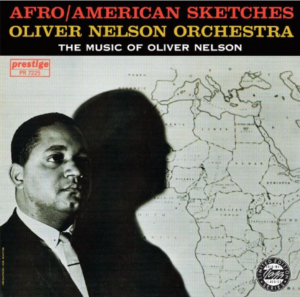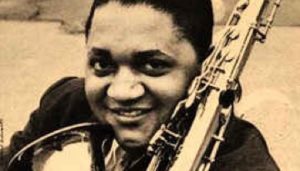The following is from Francesca Montano’s class presentation:
Oliver Nelson
- born in St. Louis, Missouri on June 4, 1932
- came from a musical family
- Nelson began playing the piano at age 6 and saxophone at 11
- 1947: playing with the Jeter-Pillars Orchestra and with St. Louis big bands
- 1951: arranged and played second alto for Louis Jordan’s big band, and followed with a period in the Navy and four years at a university
- 1960-1961: played with Quincy Jones’ orchestra
- 1959-1961: recorded six small-group albums
- Nelson was in greater demand as an arranger
- 1967: moved to Los Angeles and wrote for television and movies
- Died at age 43 from a heart attack
ABOUT THE ALBUM – AFRO/AMERICAN SKETCHES SUITE
- recorded in 1961 and released in 1962
- His first album as a leader of a big band
- Jazz critic, Richard B. Hadlock, described the album saying, “In his penchant for melodic simplicity and inner complexity he is close to the secret of Duke Ellington’s most enduring scores, and in his thick linear voicings there are echoes of Gil Evans at his best.”
- Demonstration of African American experiences in the United States and in their ancestral countries
Album Breakdown:
- “Message” – 5:56
- “Jungleaire” – 6:33
- “Emancipation Blues” – 8:11
- “There’s a Yearnin'” – 4:24
- “Going Up North” – 6:11
- “Disillusioned” – 5:36
- “Freedom Dance” – 4:39
Message:
- Homeland
- 2:11-3:15
- Dynamic between the flute and the bongos
- Representative of the conflict of rhythms that is typical in African music
- 4:56-5:15
- Connecting rhythmic African elements with typical American jazz
Jungleaire:
- Enslavement
- Hard hitting and clashing sounds
- Symbolizes the hardships and daily tortures that blacks faced while enslaved
Emancipation Blues:
- Emancipation
- Typical blues song
- Employs the use of call and response techniques
- 0:43-1:15
- 7:00-7:30
- Soulful statement
There’s a Yearning
- Reconstruction
- Somber and soulful
- Both celebrating a step forward and away from the life of slavery, while lamenting the newly implemented black codes and the persistence of white privilege and the brutality against blacks
- 3:27-3:54
Going Up North
- 20thcentury migration north
- Crisp sounding jazz
- Upbeat and punchy
- Characterized by a vibrant saxophone and upbeat drumming
- Meant to symbolize the migration of nearly 6 million blacks out of the South
Disillusioned:
- Disillusionment and continued racism in the era of civil rights
- Probably the most poetic song on the album
- Solemn with the realization that even after all the struggles for equality and getting rid of slavery, there is still prejudice and segregation
- 0:00-0:50
Freedom Dance:
- Black nationalistic movements
- Serves as a celebration of black identity
- Meant to demonstrate that black people have their own national identity and should not assimilate to white culture
Conclusion and Discussion:
- Oliver Nelson utilizes music, specifically the combination of New York jazz and African rhythms, to describe the plight of African Americans throughout history
- Combination of somber songs, upbeat songs, and other moods conveys the variety of emotions felt by Africans Americans throughout their entire history

